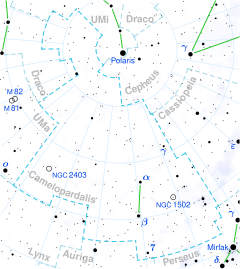1 Camelopardalis (1 Cam) is a double star system in the constellation Camelopardalis. Its combined apparent magnitude is 5.56 and it is approximately 800 parsecs (2,600 ly) away.
The 1 Camelopardalis system is part of the Camelopardalis OB1 stellar association, which is 820 pc away.[12] 1 Camelopardalis A is a hot massive star which has evolved away from the main sequence to become a giant. 1 Camelopardalis B is 10" away and is probably an early B class subgiant.
There is an 11th magnitude star 150" away.[13] It has been considered to be a member of a triple system,[12] but Gaia observations show it to be an unrelated background object.[14]

1 Camelopardalis A is a variable star with a small amplitude. It has a likely period of 0.22132 days and is thought to be a β Cephei variable or slowly pulsating B-type star.[16] Hipparcos photometry shows an amplitude of 0.035 magnitudes.[17] It has a rotational velocity of 275 km/s, one of the highest known.[10]
- ^ a b c d e Cite error: The named reference
edr3awas invoked but never defined (see the help page). - ^ a b Cite error: The named reference
tycho2was invoked but never defined (see the help page). - ^ a b c d e Cite error: The named reference
edr3bwas invoked but never defined (see the help page). - ^ Cite error: The named reference
gossswas invoked but never defined (see the help page). - ^ a b c d Cite error: The named reference
bswas invoked but never defined (see the help page). - ^ Cite error: The named reference
gcvswas invoked but never defined (see the help page). - ^ Cite error: The named reference
ubvwas invoked but never defined (see the help page). - ^ a b Cite error: The named reference
westinwas invoked but never defined (see the help page). - ^ a b c Cite error: The named reference
holgado2020was invoked but never defined (see the help page). - ^ a b Cite error: The named reference
Cazorla2017was invoked but never defined (see the help page). - ^ a b c Cite error: The named reference
simondiazwas invoked but never defined (see the help page). - ^ a b Cite error: The named reference
straizyswas invoked but never defined (see the help page). - ^ Cite error: The named reference
wdswas invoked but never defined (see the help page). - ^ Cite error: The named reference
edr3cwas invoked but never defined (see the help page). - ^ Cite error: The named reference
MASTwas invoked but never defined (see the help page). - ^ Cite error: The named reference
jerzykiewiczwas invoked but never defined (see the help page). - ^ Cite error: The named reference
lefevrewas invoked but never defined (see the help page).
